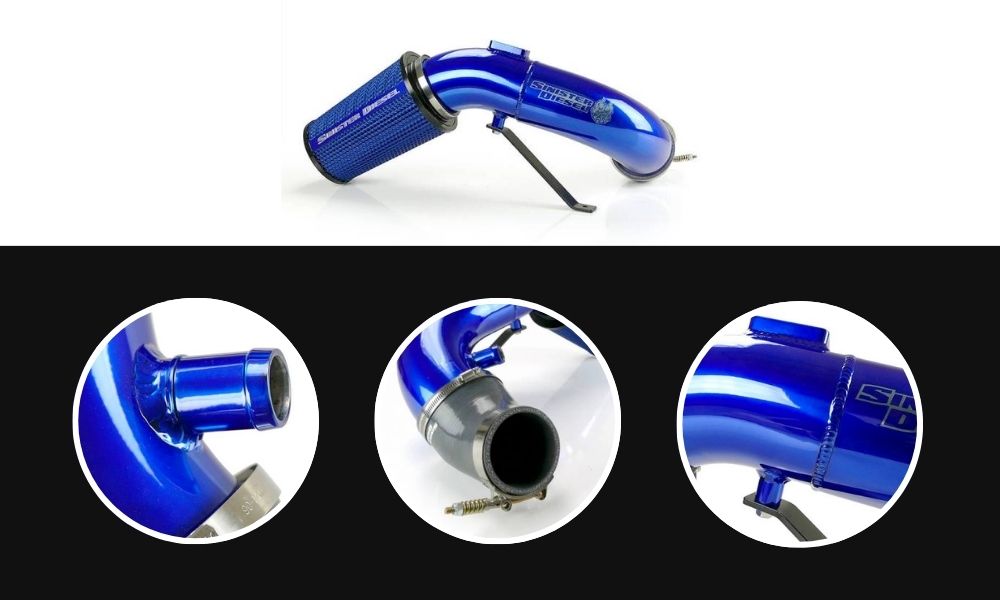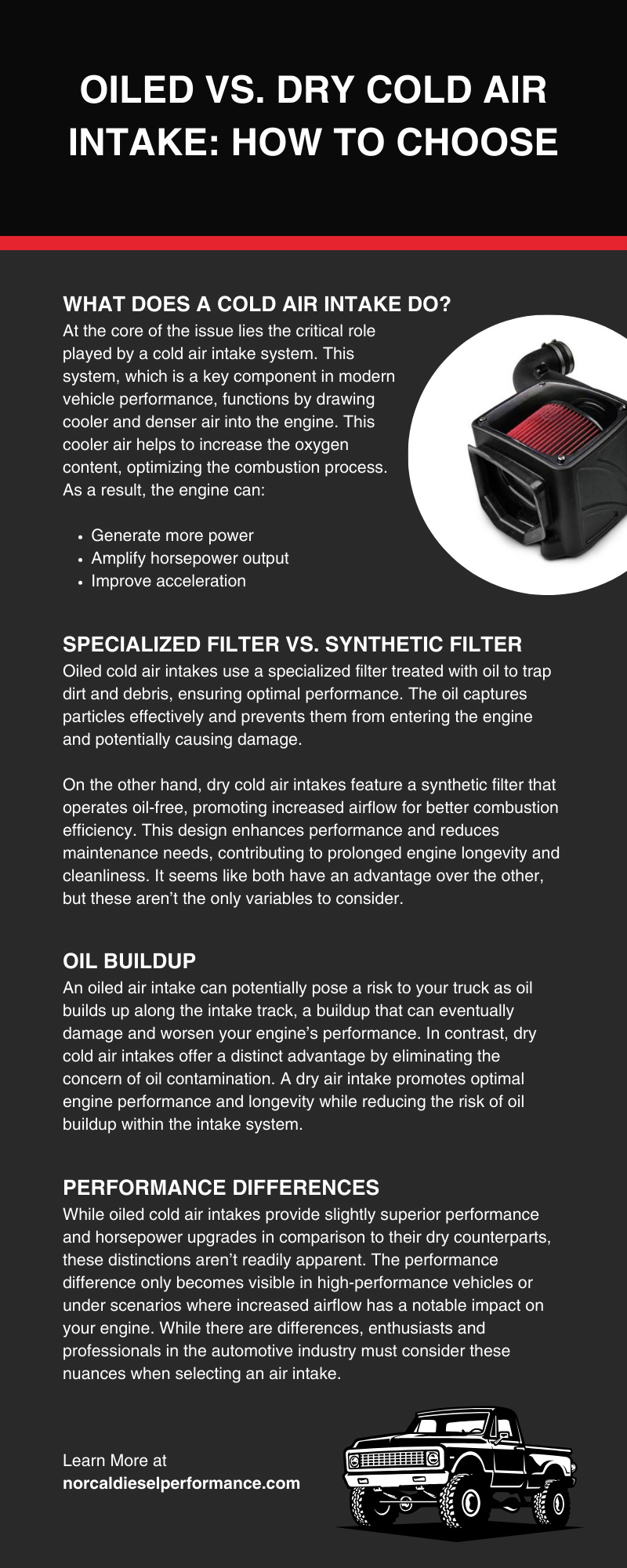


Cold air intakes can do a lot of good for you and your truck, but there’s no one-size-fits-all cold air intake. There are many different options available, and the two biggest kinds of cold air intakes you need to choose between are oiled and dry cold air intakes. There are a unique set of advantages and limitations, and with the right understanding of those differences, you can pick the cold air intake that’s right for you and your truck.
At the core of the issue lies the critical role played by a cold air intake system. This system, which is a key component in modern vehicle performance, functions by drawing cooler and denser air into the engine. This cooler air helps to increase the oxygen content, optimizing the combustion process. As a result, the engine can:
With a steady flow of fresh and cold air, your engine can operate with greater efficiency and with a lesser risk of overheating. This boost in horsepower provides greater performance, better fuel efficiency, and an improved longevity of engine components. There’s a lot to love about a cold air intake maximizing the potential of your vehicle, but which air intake is right for your truck?
Oiled cold air intakes use a specialized filter treated with oil to trap dirt and debris, ensuring optimal performance. The oil captures particles effectively and prevents them from entering the engine and potentially causing damage.
On the other hand, dry cold air intakes feature a synthetic filter that operates oil-free, promoting increased airflow for better combustion efficiency. This design enhances performance and reduces maintenance needs, contributing to prolonged engine longevity and cleanliness. It seems like both have an advantage over the other, but these aren’t the only variables to consider.
An oiled air intake can potentially pose a risk to your truck as oil builds up along the intake track, a buildup that can eventually damage and worsen your engine’s performance. In contrast, dry cold air intakes offer a distinct advantage by eliminating the concern of oil contamination. A dry air intake promotes optimal engine performance and longevity while reducing the risk of oil buildup within the intake system.
While oiled cold air intakes provide slightly superior performance and horsepower upgrades in comparison to their dry counterparts, these distinctions aren’t readily apparent. The performance difference only becomes visible in high-performance vehicles or under scenarios where increased airflow has a notable impact on your engine. While there are differences, enthusiasts and professionals in the automotive industry must consider these nuances when selecting an air intake.
Regular maintenance of oiled cold air intakes is crucial to uphold their efficiency and longevity. Perform routine cleaning to eliminate any buildup of dirt and debris, thereby ensuring optimal functionality. This upkeep task, while time-consuming, plays a vital role in preventing any potential issues down the line.
A dry cold air intake is also efficient, but it doesn’t require the same degree of maintenance. Since it doesn’t have the risk of oil buildup, a dry cold air intake can boost your engine’s longevity while decreasing the need for maintenance, resulting in a cost-free and hassle-free solution. Whether it’s oiled or dry, you must invest in maintenance to ensure your cold air intake functions properly. Maintenance reduces the risk of unexpected expenses, but it also extends the lifespan of your equipment, ultimately leading to cost savings in the long run.
Oiled cold air intakes perform exceptionally well in off-road terrains and dusty environments. By effectively capturing even the finest particles, these advanced systems offer superior engine protection and ensure optimal performance even in the most challenging conditions. Dry cold air intakes won’t catch all the dirt and rocks as an oiled air intake can, but they’re still a valid option for the occasional off-roader.
Another difference that you must consider is the cold air intake’s ability to handle humidity and moisture. While both oiled and dry cold air intakes can serve you well when off-roading, they may struggle under humid conditions. A dry cold air intake is less effective in humid conditions, but it will still keep your engine cool, maintaining optimal engine performance even in demanding circumstances. The cool, dry air helps to prevent moisture-related issues and supports efficient combustion, contributing to overall engine longevity and reliability.
Alternatively, if you live in a humid environment, a better choice is an oiled filter. These filters are less likely to allow water to pass through into the engine. These filters are incredibly beneficial in damp climates and areas with heavy rainfall and for situations when you’re off-roading through standing water. Oiled filters, due to their oil coating, can sometimes handle moisture better than dry filters, serving as a better barrier against water.
Jumping off of the last point, the climate and region you primarily drive in play an important role in choosing between oiled and dry cold air intakes. In challenging environments or during extreme weather situations, oiled intakes might require more regular maintenance to uphold optimal performance levels. Alternatively, dry cold air intakes will generally require less care and maintenance.
Oiled cold air intakes can generate higher decibel levels due to the oil-coated filter. To some drivers, that pronounced sound adds to the feeling of increased performance, but for others, the noise levels might affect their driving experience. Conversely, dry cold air intakes offer a quieter boost to performance. If you want increased efficiency and a noise-free driving environment, you want a dry cold air intake.
Now that you’ve learned the differences between oiled and dry cold air intakes, you can choose the one that complements you and your driving style. Research is an important part of finding the right air intake, but so is finding the right seller. Here at Norcal Diesel Performance, we have a wide selection of air intakes for you, including 2017–2022 6.7 Powerstroke air intakes, so you’re sure to get the one that’s right for your truck. Let Norcal Diesel Performance get you the cold air intake that optimizes your driving experience, taking your truck and engine to the next level of performance!

Sean. 2024-04-08 09:43:42
I’m glad I run with an oiled filter as it rains hard, heavy and relentlessly here on the southern Washington coast. I drive on the beach daily, so a lot of sand ends up in my truck. Fortunately though, because of the oiled air filter , no contaminants from driving on the beach end up in the motor .